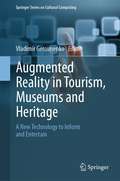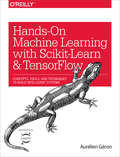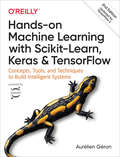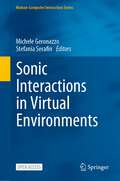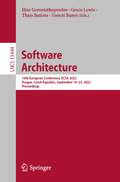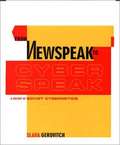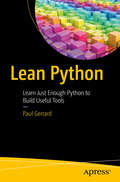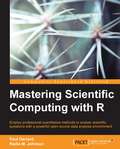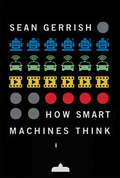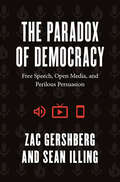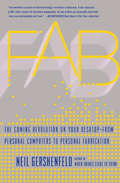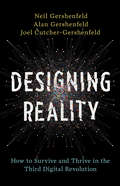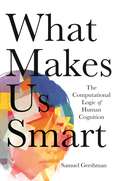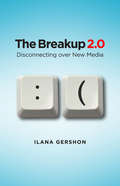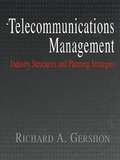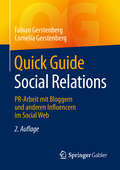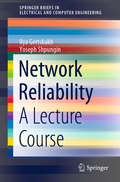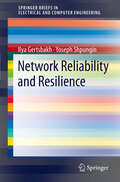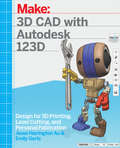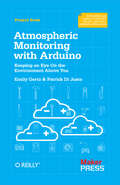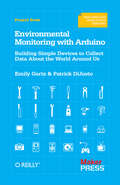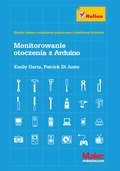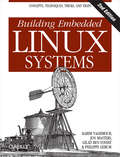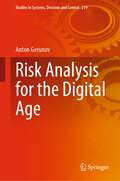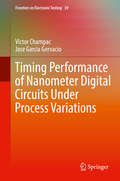- Table View
- List View
Augmented Reality in Tourism, Museums and Heritage: A New Technology to Inform and Entertain (Springer Series on Cultural Computing)
by Vladimir GeroimenkoThis book provides extensive research into the use of augmented reality in the three interconnected and overlapping fields of the tourism industry, museum exhibitions, and cultural heritage. It is written by a virtual team of 50 leading researchers and practitioners from 16 countries around the world. The authors explore the opportunities and challenges of augmented reality applications, their current status and future trends, informal learning and heritage preservation, mixed reality environments and immersive installations, cultural heritage education and tourism promotion, visitors with special needs, and emerging post-COVID-19 museums and heritage sites. Augmented Reality in Tourism, Museums and Heritage: A New Technology to Inform and Entertain is essential reading not only for researchers, application developers, educators, museum curators, tourism and cultural heritage promoters, but also for students (both graduates and undergraduates) and anyone who is interested in the efficient and practical use of augmented reality technology.
Hands-On Machine Learning with Scikit-Learn and TensorFlow: Concepts, Tools, and Techniques to Build Intelligent Systems
by Aurélien GéronGraphics in this book are printed in black and white.Through a series of recent breakthroughs, deep learning has boosted the entire field of machine learning. Now, even programmers who know close to nothing about this technology can use simple, efficient tools to implement programs capable of learning from data. This practical book shows you how.By using concrete examples, minimal theory, and two production-ready Python frameworks—scikit-learn and TensorFlow—author Aurélien Géron helps you gain an intuitive understanding of the concepts and tools for building intelligent systems. You’ll learn a range of techniques, starting with simple linear regression and progressing to deep neural networks. With exercises in each chapter to help you apply what you’ve learned, all you need is programming experience to get started. Explore the machine learning landscape, particularly neural nets; Use scikit-learn to track an example machine-learning project end-to-end; Explore several training models, including support vector machines, decision trees, random forests, and ensemble methods; Use the Tensor; Flow library to build and train neural nets; Dive into neural net architectures, including convolutional nets, recurrent nets, and deep reinforcement learning; Learn techniques for training and scaling deep neural nets; and apply practical code examples without acquiring excessive machine learning theory or algorithm details.
Hands-On Machine Learning with Scikit-Learn, Keras, and TensorFlow: Concepts, Tools, and Techniques to Build Intelligent Systems
by Aurélien GéronThrough a series of recent breakthroughs, deep learning has boosted the entire field of machine learning. Now, even programmers who know close to nothing about this technology can use simple, efficient tools to implement programs capable of learning from data. This practical book shows you how.By using concrete examples, minimal theory, and two production-ready Python frameworks—Scikit-Learn and TensorFlow—author Aurélien Géron helps you gain an intuitive understanding of the concepts and tools for building intelligent systems. You’ll learn a range of techniques, starting with simple linear regression and progressing to deep neural networks. With exercises in each chapter to help you apply what you’ve learned, all you need is programming experience to get started.Explore the machine learning landscape, particularly neural netsUse Scikit-Learn to track an example machine-learning project end-to-endExplore several training models, including support vector machines, decision trees, random forests, and ensemble methodsUse the TensorFlow library to build and train neural netsDive into neural net architectures, including convolutional nets, recurrent nets, and deep reinforcement learningLearn techniques for training and scaling deep neural nets
Sonic Interactions in Virtual Environments (Human–Computer Interaction Series)
by Michele Geronazzo Stefania SerafinThis open access book tackles the design of 3D spatial interactions in an audio-centered and audio-first perspective, providing the fundamental notions related to the creation and evaluation of immersive sonic experiences. The key elements that enhance the sensation of place in a virtual environment (VE) are:Immersive audio: the computational aspects of the acoustical-space properties of Virutal Reality (VR) technologies Sonic interaction: the human-computer interplay through auditory feedback in VEVR systems: naturally support multimodal integration, impacting different application domainsSonic Interactions in Virtual Environments will feature state-of-the-art research on real-time auralization, sonic interaction design in VR, quality of the experience in multimodal scenarios, and applications. Contributors and editors include interdisciplinary experts from the fields of computer science, engineering, acoustics, psychology, design, humanities, and beyond. Their mission is to shape an emerging new field of study at the intersection of sonic interaction design and immersive media, embracing an archipelago of existing research spread in different audio communities and to increase among the VR communities, researchers, and practitioners, the awareness of the importance of sonic elements when designing immersive environments.
Software Architecture: 16th European Conference, ECSA 2022, Prague, Czech Republic, September 19–23, 2022, Proceedings (Lecture Notes in Computer Science #13444)
by Ilias Gerostathopoulos Grace Lewis Thais Batista Tomáš BurešThis book constitutes the refereed proceedings of the 16th International Conference on Software Architecture, ECSA 2022, held in Prague in September 2022. The 9 full papers and 6 short papers were carefully selected from 47 submissions. In the Research Track, 11 full papers presented together with 5 short papers were carefully reviewed and selected from 58 submissions. The papers are organized in topical sections as follows: components, APIs and interface management; architecting for data-driven systems; microservices and middleware; architecture modeling, design and decision making; architecture reconstruction and recovery.
From Newspeak to Cyberspeak: A History of Soviet Cybernetics
by Slava GerovitchSlava argues that Soviet cybernetics was not just an intellectual trend but a social movement for radical reform in science and society as a whole. Followers of cybernetics viewed computer simulation as a universal method of problem solving
Lean Python
by Paul GerrardLearn only the essential aspects of Python without cluttering up your mind with features you may never use. This compact book is not a "best way to write code" type of book; rather, the author goes over his most-used functions, which are all you need to know as a beginner and some way beyond. Lean Python takes 58 Python methods and functions and whittles them down to 15: as author Paul Gerrard says, "I haven't found a need for the rest. " What You'll Learn Discover lean Python and how to learn just enough to build useful tools Use Python objects, program structure, I/O, modules and more Handle errors and exceptions Test your code Access the Web; do searching; and persist data Who This Book Is For This book is aimed at three categories of reader: The experienced programmer - if you already know a programming language, this book gives you a shortcut to understanding the Python language and some of its design philosophy. You work in IT and need a programming primer - you might be a tester who needs to have more informed technical discussions with programmers. Working through the examples will help you to appreciate the challenge of good programming. First-timer - you want a first book on programming that you can assimilate quickly to help you decide whether programming is for you.
Mastering Scientific Computing with R
by Paul Gerrard Radia M. JohnsonIf you want to learn how to quantitatively answer scientific questions for practical purposes using the powerful R language and the open source R tool ecosystem, this book is ideal for you. It is ideally suited for scientists who understand scientific concepts, know a little R, and want to be able to start applying R to be able to answer empirical scientific questions. Some R exposure is helpful, but not compulsory.
How Smart Machines Think (The\mit Press Ser.)
by Sean GerrishEverything you've always wanted to know about self-driving cars, Netflix recommendations, IBM's Watson, and video game-playing computer programs.The future is here: Self-driving cars are on the streets, an algorithm gives you movie and TV recommendations, IBM's Watson triumphed on Jeopardy over puny human brains, computer programs can be trained to play Atari games. But how do all these things work? In this book, Sean Gerrish offers an engaging and accessible overview of the breakthroughs in artificial intelligence and machine learning that have made today's machines so smart.Gerrish outlines some of the key ideas that enable intelligent machines to perceive and interact with the world. He describes the software architecture that allows self-driving cars to stay on the road and to navigate crowded urban environments; the million-dollar Netflix competition for a better recommendation engine (which had an unexpected ending); and how programmers trained computers to perform certain behaviors by offering them treats, as if they were training a dog. He explains how artificial neural networks enable computers to perceive the world—and to play Atari video games better than humans. He explains Watson's famous victory on Jeopardy, and he looks at how computers play games, describing AlphaGo and Deep Blue, which beat reigning world champions at the strategy games of Go and chess. Computers have not yet mastered everything, however; Gerrish outlines the difficulties in creating intelligent agents that can successfully play video games like StarCraft that have evaded solution—at least for now. Gerrish weaves the stories behind these breakthroughs into the narrative, introducing readers to many of the researchers involved, and keeping technical details to a minimum. Science and technology buffs will find this book an essential guide to a future in which machines can outsmart people.
The Paradox of Democracy: Free Speech, Open Media, and Perilous Persuasion
by Zac Gershberg Sean IllingA thought-provoking history of communications that challenges ideas about freedom of speech and democracy. At the heart of democracy lies a contradiction that cannot be resolved, one that has affected free societies since their advent: Though freedom of speech and media has always been a necessary condition of democracy, that very freedom is also its greatest threat. When new forms of communication arrive, they often bolster the practices of democratic politics. But the more accessible the media of a society, the more susceptible that society is to demagoguery, distraction, and spectacle. Tracing the history of media disruption and the various responses to it over time, Zac Gershberg and Sean Illing reveal how these changes have challenged democracy—often with unsettling effects. The Paradox of Democracy captures the deep connection between communication and political culture, from the ancient art of rhetoric and the revolutionary role of newspapers to liberal broadcast media and the toxic misinformation of the digital public sphere. With clear-eyed analysis, Gershberg and Illing show that our contemporary debates over media, populism, and cancel culture are not too different from the democratic cultural experiences of the past. As we grapple with a fast-changing, hyper-digital world, they prove democracy is always perched precipitously on a razor’s edge, now as ever before.
Fab: The Coming Revolution on Your Desktop--from Personal Computers to Personal Fabrication
by Neil GershenfeldWhat if you could someday put the manufacturing power of an automobile plant on your desktop? According to Neil Gershenfeld, the renowned MIT scientist and inventor, the next big thing is personal fabrication-the ability to design and produce your own products, in your own home, with a machine that combines consumer electronics and industrial tools. Personal fabricators are about to revolutionize the world just as personal computers did a generation ago, and Fab shows us how.
Designing Reality: How to Survive and Thrive in the Third Digital Revolution
by Neil Gershenfeld Alan Gershenfeld Joel Cutcher-GershenfeldThat's the promise, and peril, of the third digital revolution, where anyone will be able to make (almost) anythingTwo digital revolutions--computing and communication--have radically transformed our economy and lives. A third digital revolution is here: fabrication. Today's 3D printers are only the start of a trend, accelerating exponentially, to turn data into objects: Neil Gershenfeld and his collaborators ultimately aim to create a universal replicator straight out of Star Trek. While digital fabrication promises us self-sufficient cities and the ability to make (almost) anything, it could also lead to massive inequality. The first two digital revolutions caught most of the world flat-footed, thanks to Designing Reality that won't be true this time.
What Makes Us Smart: The Computational Logic of Human Cognition
by Samuel GershmanHow a computational framework can account for the successes and failures of human cognitionAt the heart of human intelligence rests a fundamental puzzle: How are we incredibly smart and stupid at the same time? No existing machine can match the power and flexibility of human perception, language, and reasoning. Yet, we routinely commit errors that reveal the failures of our thought processes. What Makes Us Smart makes sense of this paradox by arguing that our cognitive errors are not haphazard. Rather, they are the inevitable consequences of a brain optimized for efficient inference and decision making within the constraints of time, energy, and memory—in other words, data and resource limitations. Framing human intelligence in terms of these constraints, Samuel Gershman shows how a deeper computational logic underpins the “stupid” errors of human cognition.Embarking on a journey across psychology, neuroscience, computer science, linguistics, and economics, Gershman presents unifying principles that govern human intelligence. First, inductive bias: any system that makes inferences based on limited data must constrain its hypotheses in some way before observing data. Second, approximation bias: any system that makes inferences and decisions with limited resources must make approximations. Applying these principles to a range of computational errors made by humans, Gershman demonstrates that intelligent systems designed to meet these constraints yield characteristically human errors.Examining how humans make intelligent and maladaptive decisions, What Makes Us Smart delves into the successes and failures of cognition.
The Breakup 2.0: Disconnecting over New Media
by Ilana GershonA few generations ago, college students showed their romantic commitments by exchanging special objects: rings, pins, varsity letter jackets. Pins and rings were handy, telling everyone in local communities that you were spoken for, and when you broke up, the absence of a ring let everyone know you were available again. Is being Facebook official really more complicated, or are status updates just a new version of these old tokens? Many people are now fascinated by how new media has affected the intricacies of relationships and their dissolution. People often talk about Facebook and Twitter as platforms that have led to a seismic shift in transparency and (over)sharing. What are the new rules for breaking up? These rules are argued over and mocked in venues from the New York Times to lamebook. com, but well-thought-out and informed considerations of the topic are rare. Ilana Gershon was intrigued by the degree to which her students used new media to communicate important romantic information-such as "it's over. " She decided to get to the bottom of the matter by interviewing seventy-two people about how they use Skype, texting, voice mail, instant messaging, Facebook, and cream stationery to end relationships. She opens up the world of romance as it is conducted in a digital milieu, offering insights into the ways in which different media influence behavior, beliefs, and social mores. Above all, this full-fledged ethnography of Facebook and other new tools is about technology and communication, but it also tells the reader a great deal about what college students expect from each other when breaking up-and from their friends who are the spectators or witnesses to the ebb and flow of their relationships. The Breakup 2. 0 is accessible and riveting.
Telecommunications Management
by Richard GershonWith today's communications industry experiencing major changes on an almost daily basis, media managers must have a clear understanding of the different delivery platforms, as well as a grasp of critical management, planning, and economic factors in order to stay current and move their organizations forward. Telecommunications Management helps current and future media professionals understand the relationship and convergence patterns between the broadcast, cable television, telephony, and Internet communication industries. Author Richard A. Gershon examines telecommunications industry structures and the management practices and business strategies affecting the delivery of information and entertainment services to consumers. He brings in specialists to present the finer points of management and planning responsibilities. Case studies from the International Radio and Television Society (IRTS) competition supplement the main text and offer an invaluable perspective on management issues. Developed for students in telecommunications management, electronic media management, and telecommunication economics, this volume also serves as a practical reference for the professional manager.
Quick Guide Social Relations: PR-Arbeit mit Bloggern und anderen Influencern im Social Web (Quick Guide)
by Fabian Gerstenberg Cornelia GerstenbergDieses Buch zeigt, wie PR-Schaffende erfolgreich mit Bloggern und anderen einflussreichen Akteuren des Social Webs interagieren können. Die Autoren bieten in diesem Quick Guide einen schnellen und direkt anwendbaren Zugang zu den neuen Kommunikationsregeln im Internet, konkrete Handlungsempfehlungen für Blogger Relations und zielgerichtete Impulse, um die Öffentlichkeitsarbeit mit reichweitenstarken Multiplikatoren und Influencern im Netz professionell zu optimieren. Außerdem: Erfolgreiche Blogger geben Branchen-Insights und erklären, wie man gut mit ihnen ins Gespräch kommt.Neu in der aktualisierten 2. Auflage: Zahlreiche Transferübungen für die direkte Anwendung in der Praxis.
Network Reliability: A Lecture Course (SpringerBriefs in Electrical and Computer Engineering)
by Ilya Gertsbakh Yoseph ShpunginThis introductory book equips the reader to apply the core concepts and methods of network reliability analysis to real-life problems. It explains the modeling and critical analysis of systems and probabilistic networks, and requires only a minimal background in probability theory and computer programming. Based on the lecture notes of eight courses taught by the authors, the book is also self-contained, with no theory needed beyond the lectures. The primary focus is on essential “modus operandi,” which are illustrated in numerous examples and presented separately from the more difficult theoretical material.
Network Reliability and Resilience
by Ilya Gertsbakh Yoseph ShpunginThis book is devoted to the probabilistic description of the behavior of a network in the process of random removal of its components (links, nodes) appearing as a result of technical failures, natural disasters or intentional attacks. It is focused on a practical approach to network reliability and resilience evaluation, based on applications of Monte Carlo methodology to numerical approximation of network combinatorial invariants, including so-called multidimensional destruction spectra. This allows to develop a probabilistic follow-up analysis of the network in the process of its gradual destruction, to identify most important network components and to develop efficient heuristic algorithms for network optimal design. Our methodology works with satisfactory accuracy and efficiency for most applications of reliability theory to real -life problems in networks.
3D CAD with Autodesk 123D
by Emily Gertz Jesse Harrington AuIf you've arrived at a stage in your creative life where you're ready to do more with your computer, it's time to learn how to combine its power with new advances in computer-aided design (CAD) and fabrication to make something awesome--in three dimensions!<P><P> The free suite of Autodesk 123D software offers all the tools you need to capture or design three-dimensional objects and characters. This book tells you how to harness that power to print or fabricate just about anything you can imagine. Want to make something mechanical or structural that's based on precise measurements? 123D Design can help! Ready to create something cool based on a character, an organic shape, or something found in nature? 123D Catch, 123D Meshmixer, and 123D Sculpt+ will assist. Learn how to use these tools, plus 123D Make--perfect for prototyping designs you'll cut with a CNC mill--to take your creativity to a new level.An ideal book for Makers, hobbyists, students, artists, and designers (including beginners!), this book opens up the inexpensive world of personal fabrication to everyone.In 3D CAD with Autodesk 123D, you'll:Meet the classic "Stanford bunny" and learn to modify it with MeshmixerScan and 3D print anything around youDesign your own 3D-printed guitarFind models in the Sculpt+ community and make a skeleton!Build a birdhouse, prototype a playground, or create a statueLearn everything from basics to troubleshooting skillsGet started making right away
Atmospheric Monitoring with Arduino
by Emily Gertz Patrick Di JustoMakers around the globe are building low-cost devices to monitor the environment, and with this hands-on guide, so can you. Through succinct tutorials, illustrations, and clear step-by-step instructions, you'll learn how to create gadgets for examining the quality of our atmosphere, using Arduino and several inexpensive sensors. Detect harmful gases, dust particles such as smoke and smog, and upper atmospheric haze--substances and conditions that are often invisible to your senses. You'll also discover how to use the scientific method to help you learn even more from your atmospheric tests. Get up to speed on Arduino with a quick electronics primer Build a tropospheric gas sensor to detect carbon monoxide, LPG, butane, methane, benzene, and many other gases Create an LED Photometer to measure how much of the sun's blue, green, and red light waves are penetrating the atmosphere Build an LED sensitivity detector--and discover which light wavelengths each LED in your Photometer is receptive to Learn how measuring light wavelengths lets you determine the amount of water vapor, ozone, and other substances in the atmosphere Upload your data to Cosm and share it with others via the Internet "The future will rely on citizen scientists collecting and analyzing their own data. The easy and fun gadgets in this book show everyone from Arduino beginners to experienced Makers how best to do that." --Chris Anderson, Editor in Chief of Wired magazine, author of Makers: The New Industrial Revolution (Crown Business)
Environmental Monitoring with Arduino
by Emily Gertz Patrick Di Justo<p>Right now, thousands of people worldwide are tracking environmental conditions with monitoring devices they’ve built themselves. You can do it too! This inspiring guide shows you how to use Arduino to create gadgets for measuring noise, weather, electromagnetic interference (EMI), water purity, and more. You’ll also learn how to collect and share your own data, and you can experiment by creating your own variations of the gadgets covered in the book. If you’re new to DIY electronics, the first chapter offers a primer on electronic circuits and Arduino programming.</p>
Monitorowanie otoczenia z Arduino
by Emily Gertz Patrick Di JustoZbuduj w?asne urz?dzenia pomiarowe z platform? Arduino!Arduino to niesamowita platforma, która otworzy?a przed ?wiatem elektroniki mnóstwo nowych mo?liwo?ci. Dzi?ki prostocie obs?ugi zdoby?a rzesz? zwolenników, a to prze?o?y?o si? na ilo?? dost?pnych w sieci materia?ów i publikacji. Dla platformy Arduino opracowano liczne akcesoria, które pozwalaj? u?ytkownikowi rozbudowa? ka?dy uk?ad. Dodatkowo istnieje te? mo?liwo?? po??czenia jej z kolejn? popularn? platform? — Raspberry Pi. Z tym duetem osi?gniesz wszystko!Ten fantastyczny podr?cznik poka?e Ci, jak wykorzysta? Arduino do zbierania informacji o otaczaj?cym ?wiecie. Pomiar poziomu ha?asu, temperatury i wilgotno?ci to tylko cz??? projektów, które mo?esz zrealizowa? dzi?ki tej platformie. W trakcie lektury dowiesz si?, jak wykorzysta? modu? sieciowy oraz zaprezentowa? zebrane dane na wy?wietlaczu. Chcia?by? mie? swój w?asny licznik Geigera? To cudo jest w Twoim zasi?gu! Podczas realizacji przedstawionych tu projektów poznasz platform? Arduino i zaczniesz tworzy? w?asne uk?ady. Si?gnij po t? ksi??k? i zanurz si? w ?wiat uk?adów elektronicznych.Zbuduj swój w?asny: termometr miernik ha?asu licznik Geigera wymarzony uk?ad z platform? Arduino!Arduino — Twoja przepustka do ?wiata elektroniki!
Building Embedded Linux Systems
by Philippe Gerum Jon Masters Gilad Ben-Yossef Karim YaghmourThere's a great deal of excitement surrounding the use of Linux in embedded systems -- for everything from cell phones to car ABS systems and water-filtration plants -- but not a lot of practical information. Building Embedded Linux Systems offers an in-depth, hard-core guide to putting together embedded systems based on Linux. Updated for the latest version of the Linux kernel, this new edition gives you the basics of building embedded Linux systems, along with the configuration, setup, and use of more than 40 different open source and free software packages in common use. The book also looks at the strengths and weaknesses of using Linux in an embedded system, plus a discussion of licensing issues, and an introduction to real-time, with a discussion of real-time options for Linux. This indispensable book features arcane and previously undocumented procedures for: Building your own GNU development toolchain Using an efficient embedded development framework Selecting, configuring, building, and installing a target-specific kernel Creating a complete target root filesystem Setting up, manipulating, and using solid-state storage devices Installing and configuring a bootloader for the target Cross-compiling a slew of utilities and packages Debugging your embedded system using a plethora of tools and techniques Using the uClibc, BusyBox, U-Boot, OpenSSH, thttpd, tftp, strace, and gdb packages By presenting how to build the operating system components from pristine sources and how to find more documentation or help, Building Embedded Linux Systems greatly simplifies the task of keeping complete control over your embedded operating system.
Risk Analysis for the Digital Age (Studies in Systems, Decision and Control #219)
by Anton GerunovThis book presents a foray into the fascinating process of risk management, beginning from classical methods and approaches to understanding risk all the way into cutting-age thinking. Risk management by necessity must lie at the heart of governing our ever more complex digital societies. New phenomena and activities necessitate a new look at how individuals, firms, and states manage the uncertainty they must operate in. Initial chapters provide an introduction to traditional methods and show how they can be built upon to better understand the workings of the modern economy. Later chapters review digital activities and assets like cryptocurrencies showing how such emergent risks can be conceptualized better. Network theory figures prominently and the book demonstrates how it can be used to gauge the risk in the digital sectors of the economy. Predicting the unpredictable black swan events is also discussed in view of a wider adoption of economic simulations. The journey concludes by looking at how individuals perceive risk and make decisions as they operate in a virtual social network. This book interests the academic audience, but it also features insights and novel research results that are relevant for practitioners and policymakers.
Timing Performance of Nanometer Digital Circuits Under Process Variations (Frontiers In Electronic Testing Ser. #39)
by Jose Garcia Gervacio Victor ChampacThis book discusses the digital design of integrated circuits under process variations, with a focus on design-time solutions. The authors describe a step-by-step methodology, going from logic gates to logic paths to the circuit level. Topics are presented in comprehensively, without overwhelming use of analytical formulations. Emphasis is placed on providing digital designers with understanding of the sources of process variations, their impact on circuit performance and tools for improving their designs to comply with product specifications. Various circuit-level “design hints” are highlighted, so that readers can use then to improve their designs. A special treatment is devoted to unique design issues and the impact of process variations on the performance of FinFET based circuits. This book enables readers to make optimal decisions at design time, toward more efficient circuits, with better yield and higher reliability.
